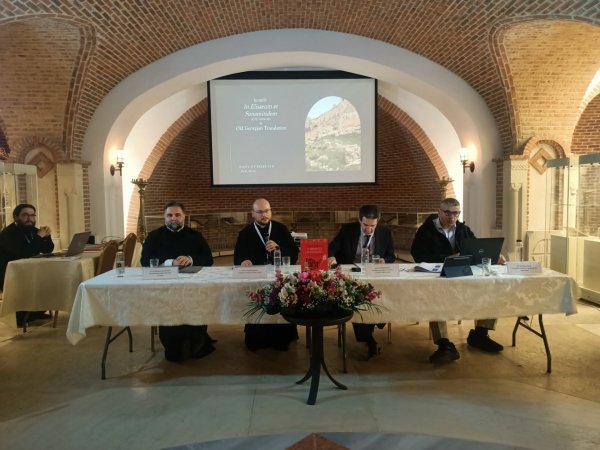On May 12-13 of this year, the 17th Annual International Symposium “Studia Theologica Doctoralia” was held in the Romanian city of Iasi. The symposium was dedicated to Romanian martyrs and confessors of the twentieth century; its main topic was: On the Essence of Suffering for the sake of God.
A plenary session was held on May 12. It was attended by Metropolitan Teofan of Moldavia and Bukovina, as well as numerous professors and doctoral students from Iasi, other cities in Romania and foreign countries.
At the session, the Head of the doctoral program of Tbilisi Theological Academy and Seminary, Doctor of Theology, Priest Tsotne Chkheidze gave a talk on the topic: Basil of Seleucia’s Homily on the Prophet Elisha and the Shunammite Woman and Its Old Georgian Translation.
The Greek text of the aforementioned sermon of Basil of Seleucia has survived in five manuscripts. It was published three times - in 1596, 1622, and 1864. Its Old Georgian translation has survived in two manuscripts (S-417, 12th century, Kut.3, 15th century), however, its critical text has not yet been published. While determining the critical text, Priest Tsotne Chkheidze discovered that the Old Georgian translation, which is done in the style of Gelati school, is of a different edition.
Priest Tsotne Chkheidze spoke about the aforementioned differences, explaining the importance of the Old Georgian translation for the study of Basil of Seleucia as a preacher and his Christology. The discussion of these issues was conducted in parallel with the discussion of the content of the sermon.
This sermon is related to the miracle of the prophet Elisha when he raised the son of a Shunammite woman from the dead, described in the Book of Kings (see 2 Kings 4:32-37). Basil of Seleucia draws attention to the fact that the prophet not only implores the Lord in his prayer, but also performs a certain symbolic action, which has a prophetic essence. It is connected with the Incarnation of the Son of God - the full assumption of human nature (without sin), the renewal of the image of God in it and the salvation of humanity. The preacher discusses in detail the significance of the symbolic action and draws a parallel with the miracle described in the Gospel of Luke - the restoration of the son of the widow of Nain by Jesus Christ (see Luke 7:11-15).
Of particular importance is the part of the sermon where Basil of Seleucia quotes the following passage from the Epistle of the Apostle Paul to the Colossians: “For in Him dwells all the fullness of the Godhead bodily” (Colossians 2:9). Basil of Seleucia presents this sentence in his sermon with certain peculiarities which are clearly conveyed in the Old Georgian translation. Priest Tsotne Chkheidze spoke in detail about the dogmatic content of the aforementioned issues and discussed them in the light of Saint John of Damascus’ “An Exact Exposition of the Orthodox Faith”.
The talk aroused
great interest among the audience and was followed by an exchange
of ideas when significant opinions were expressed.



